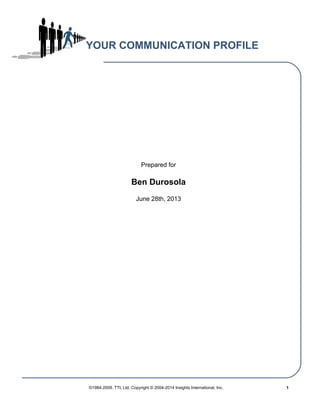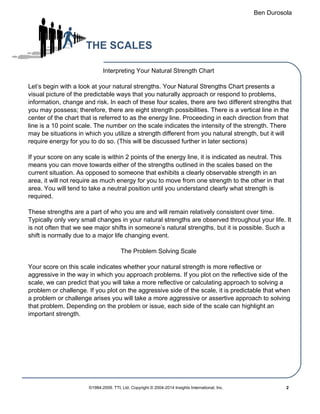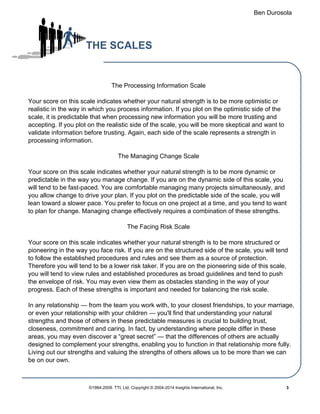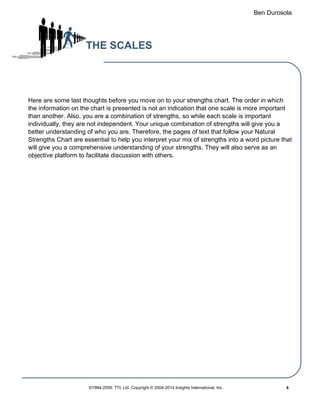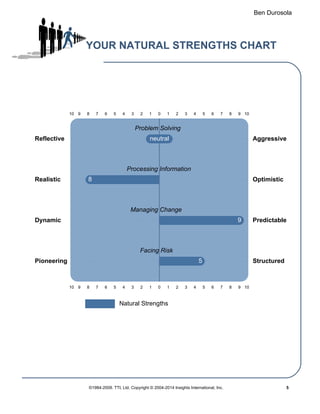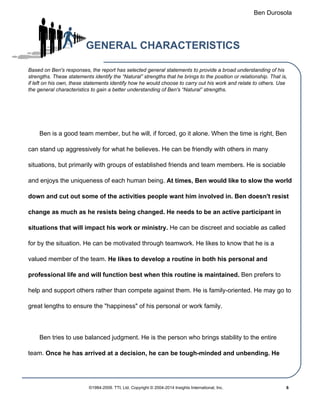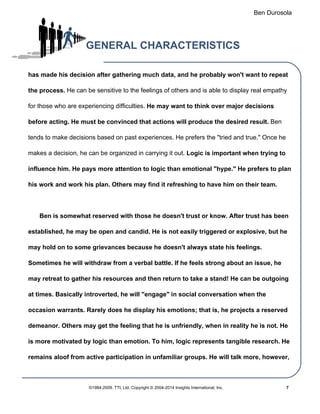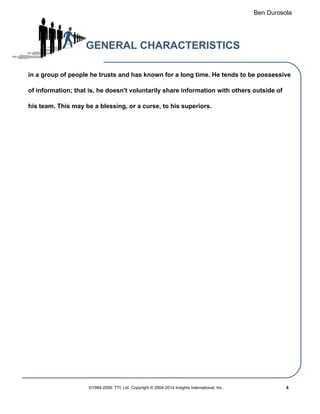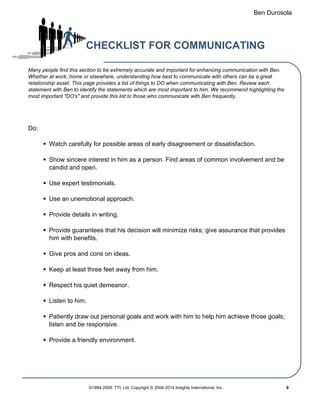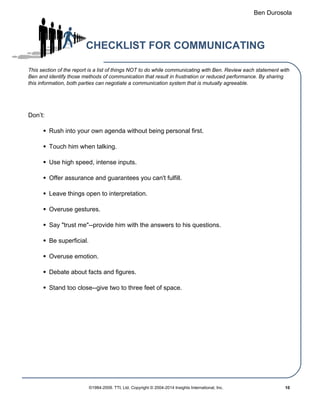Ben Durosola
- 1. YOUR COMMUNICATION PROFILE Prepared for Ben Durosola June 28th, 2013 ┬®1984-2009. TTI, Ltd. Copyright ┬® 2004-2014 Insights International, Inc. 1
- 2. Ben Durosola THE SCALES Interpreting Your Natural Strength Chart LetŌĆÖs begin with a look at your natural strengths. Your Natural Strengths Chart presents a visual picture of the predictable ways that you naturally approach or respond to problems, information, change and risk. In each of these four scales, there are two different strengths that you may possess; therefore, there are eight strength possibilities. There is a vertical line in the center of the chart that is referred to as the energy line. Proceeding in each direction from that line is a 10 point scale. The number on the scale indicates the intensity of the strength. There may be situations in which you utilize a strength different from you natural strength, but it will require energy for you to do so. (This will be discussed further in later sections) If your score on any scale is within 2 points of the energy line, it is indicated as neutral. This means you can move towards either of the strengths outlined in the scales based on the current situation. As opposed to someone that exhibits a clearly observable strength in an area, it will not require as much energy for you to move from one strength to the other in that area. You will tend to take a neutral position until you understand clearly what strength is required. These strengths are a part of who you are and will remain relatively consistent over time. Typically only very small changes in your natural strengths are observed throughout your life. It is not often that we see major shifts in someoneŌĆÖs natural strengths, but it is possible. Such a shift is normally due to a major life changing event. The Problem Solving Scale Your score on this scale indicates whether your natural strength is more reflective or aggressive in the way in which you approach problems. If you plot on the reflective side of the scale, we can predict that you will take a more reflective or calculating approach to solving a problem or challenge. If you plot on the aggressive side of the scale, it is predictable that when a problem or challenge arises you will take a more aggressive or assertive approach to solving that problem. Depending on the problem or issue, each side of the scale can highlight an important strength. ┬®1984-2009. TTI, Ltd. Copyright ┬® 2004-2014 Insights International, Inc. 2
- 3. Ben Durosola THE SCALES The Processing Information Scale Your score on this scale indicates whether your natural strength is to be more optimistic or realistic in the way in which you process information. If you plot on the optimistic side of the scale, it is predictable that when processing new information you will be more trusting and accepting. If you plot on the realistic side of the scale, you will be more skeptical and want to validate information before trusting. Again, each side of the scale represents a strength in processing information. The Managing Change Scale Your score on this scale indicates whether your natural strength is to be more dynamic or predictable in the way you manage change. If you are on the dynamic side of this scale, you will tend to be fast-paced. You are comfortable managing many projects simultaneously, and you allow change to drive your plan. If you plot on the predictable side of the scale, you will lean toward a slower pace. You prefer to focus on one project at a time, and you tend to want to plan for change. Managing change effectively requires a combination of these strengths. The Facing Risk Scale Your score on this scale indicates whether your natural strength is to be more structured or pioneering in the way you face risk. If you are on the structured side of the scale, you will tend to follow the established procedures and rules and see them as a source of protection. Therefore you will tend to be a lower risk taker. If you are on the pioneering side of this scale, you will tend to view rules and established procedures as broad guidelines and tend to push the envelope of risk. You may even view them as obstacles standing in the way of your progress. Each of these strengths is important and needed for balancing the risk scale. In any relationship ŌĆö from the team you work with, to your closest friendships, to your marriage, or even your relationship with your children ŌĆö you'll find that understanding your natural strengths and those of others in these predictable measures is crucial to building trust, closeness, commitment and caring. In fact, by understanding where people differ in these areas, you may even discover a ŌĆ£great secretŌĆØ ŌĆö that the differences of others are actually designed to complement your strengths, enabling you to function in that relationship more fully. Living out our strengths and valuing the strengths of others allows us to be more than we can be on our own. ┬®1984-2009. TTI, Ltd. Copyright ┬® 2004-2014 Insights International, Inc. 3
- 4. Ben Durosola THE SCALES Here are some last thoughts before you move on to your strengths chart. The order in which the information on the chart is presented is not an indication that one scale is more important than another. Also, you are a combination of strengths, so while each scale is important individually, they are not independent. Your unique combination of strengths will give you a better understanding of who you are. Therefore, the pages of text that follow your Natural Strengths Chart are essential to help you interpret your mix of strengths into a word picture that will give you a comprehensive understanding of your strengths. They will also serve as an objective platform to facilitate discussion with others. ┬®1984-2009. TTI, Ltd. Copyright ┬® 2004-2014 Insights International, Inc. 4
- 5. Ben Durosola YOUR NATURAL STRENGTHS CHART 10 9 8 7 6 5 4 3 2 1 0 1 2 3 4 5 6 7 8 9 10 10 9 8 7 6 5 4 3 2 1 0 1 2 3 4 5 6 7 8 9 10 Reflective Realistic Dynamic Pioneering Aggressive Optimistic Predictable Structured Problem Solving Processing Information Managing Change Facing Risk neutral 8 9 5 Natural Strengths ┬®1984-2009. TTI, Ltd. Copyright ┬® 2004-2014 Insights International, Inc. 5
- 6. Ben Durosola GENERAL CHARACTERISTICS Based on Ben's responses, the report has selected general statements to provide a broad understanding of his strengths. These statements identify the ŌĆ£NaturalŌĆØ strengths that he brings to the position or relationship. That is, if left on his own, these statements identify how he would choose to carry out his work and relate to others. Use the general characteristics to gain a better understanding of Ben's ŌĆ£NaturalŌĆØ strengths. Ben is a good team member, but he will, if forced, go it alone. When the time is right, Ben can stand up aggressively for what he believes. He can be friendly with others in many situations, but primarily with groups of established friends and team members. He is sociable and enjoys the uniqueness of each human being. At times, Ben would like to slow the world down and cut out some of the activities people want him involved in. Ben doesn't resist change as much as he resists being changed. He needs to be an active participant in situations that will impact his work or ministry. He can be discreet and sociable as called for by the situation. He can be motivated through teamwork. He likes to know that he is a valued member of the team. He likes to develop a routine in both his personal and professional life and will function best when this routine is maintained. Ben prefers to help and support others rather than compete against them. He is family-oriented. He may go to great lengths to ensure the "happiness" of his personal or work family. Ben tries to use balanced judgment. He is the person who brings stability to the entire team. Once he has arrived at a decision, he can be tough-minded and unbending. He ┬®1984-2009. TTI, Ltd. Copyright ┬® 2004-2014 Insights International, Inc. 6
- 7. Ben Durosola GENERAL CHARACTERISTICS has made his decision after gathering much data, and he probably won't want to repeat the process. He can be sensitive to the feelings of others and is able to display real empathy for those who are experiencing difficulties. He may want to think over major decisions before acting. He must be convinced that actions will produce the desired result. Ben tends to make decisions based on past experiences. He prefers the "tried and true." Once he makes a decision, he can be organized in carrying it out. Logic is important when trying to influence him. He pays more attention to logic than emotional "hype." He prefers to plan his work and work his plan. Others may find it refreshing to have him on their team. Ben is somewhat reserved with those he doesn't trust or know. After trust has been established, he may be open and candid. He is not easily triggered or explosive, but he may hold on to some grievances because he doesn't always state his feelings. Sometimes he will withdraw from a verbal battle. If he feels strong about an issue, he may retreat to gather his resources and then return to take a stand! He can be outgoing at times. Basically introverted, he will "engage" in social conversation when the occasion warrants. Rarely does he display his emotions; that is, he projects a reserved demeanor. Others may get the feeling that he is unfriendly, when in reality he is not. He is more motivated by logic than emotion. To him, logic represents tangible research. He remains aloof from active participation in unfamiliar groups. He will talk more, however, ┬®1984-2009. TTI, Ltd. Copyright ┬® 2004-2014 Insights International, Inc. 7
- 8. Ben Durosola GENERAL CHARACTERISTICS in a group of people he trusts and has known for a long time. He tends to be possessive of information; that is, he doesn't voluntarily share information with others outside of his team. This may be a blessing, or a curse, to his superiors. ┬®1984-2009. TTI, Ltd. Copyright ┬® 2004-2014 Insights International, Inc. 8
- 9. Ben Durosola CHECKLIST FOR COMMUNICATING Many people find this section to be extremely accurate and important for enhancing communication with Ben. Whether at work, home or elsewhere, understanding how best to communicate with others can be a great relationship asset. This page provides a list of things to DO when communicating with Ben. Review each statement with Ben to identify the statements which are most important to him. We recommend highlighting the most important "DO's" and provide this list to those who communicate with Ben frequently. Do: Watch carefully for possible areas of early disagreement or dissatisfaction. Show sincere interest in him as a person. Find areas of common involvement and be candid and open. Use expert testimonials. Use an unemotional approach. Provide details in writing. Provide guarantees that his decision will minimize risks; give assurance that provides him with benefits. Give pros and cons on ideas. Keep at least three feet away from him. Respect his quiet demeanor. Listen to him. Patiently draw out personal goals and work with him to help him achieve those goals; listen and be responsive. Provide a friendly environment. ┬®1984-2009. TTI, Ltd. Copyright ┬® 2004-2014 Insights International, Inc. 9
- 10. Ben Durosola CHECKLIST FOR COMMUNICATING This section of the report is a list of things NOT to do while communicating with Ben. Review each statement with Ben and identify those methods of communication that result in frustration or reduced performance. By sharing this information, both parties can negotiate a communication system that is mutually agreeable. DonŌĆÖt: Rush into your own agenda without being personal first. Touch him when talking. Use high speed, intense inputs. Offer assurance and guarantees you can't fulfill. Leave things open to interpretation. Overuse gestures. Say "trust me"--provide him with the answers to his questions. Be superficial. Overuse emotion. Debate about facts and figures. Stand too close--give two to three feet of space. Powered by TCPDF (www.tcpdf.org) ┬®1984-2009. TTI, Ltd. Copyright ┬® 2004-2014 Insights International, Inc. 10
